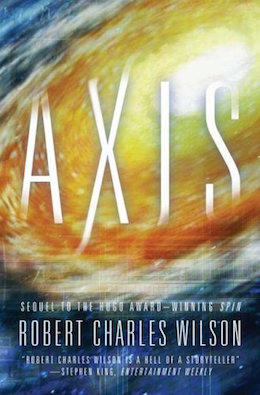Welcome back to the Tor.com eBook Club! November’s pick is Spin, the first book in a sci-fi trilogy from Robert Charles Wilson. The following essay, originally published July 2011, is an in-depth reread of Axis, book two in the trilogy, so beware of major spoilers! You can also head back and read Stefan’s thoughts on Spin.
Many readers expressed disappointment about the long-awaited sequel to Spin. Looking back now, it’s understandable that people felt let down. Expecting a better novel than Spin was probably unrealistic. Even expecting something just as good was, in retrospect, on the hopeful side, given how high Robert Charles Wilson set the bar with the first novel. Regardless, I feel that Axis is a good—if not great—novel that adds a new dimension to the Spin universe and builds a solid bridge to the third volume, Vortex.
What follows contains huge spoilers for Spin and Axis, but nothing about Vortex.
Axis is set about 30 years after the end of Spin and takes place on Equatoria, the New World Diane and Tyler were traveling to at the end of the first novel. The first shock of the novel is the almost completely new set of characters. Diane appears later in the novel, but early on we’re stuck with an all new bunch of new people, some more interesting than others.
The first chapter introduces Isaac, who is initially a bit of a mystery but eventually turns out to be an attempt (by a clandestine group of Fourths) to create a “communicant.” From the end of Spin we know that a more advanced version of the treatment that turns ordinary people into Fourths can enable something like communication with the galaxy-spanning network of artificial life known as the Hypotheticals. However, as we saw with Jason, this ends up being a fatal proposition for the subject. Hence Isaac, who was injected with the treatment in utero in the hopes of producing a human who can communicate with the Hypotheticals.
This first chapter also introduces some of the Fourths who are responsible for Isaac, including Dr. Dvali, who is the obsessive driving force behind the group, and Mrs. Rebka, who turns out to be Isaac’s biological mother. We also meet Sulean Moi, who was part of a second Martian mission to Earth and somehow managed to stay behind when the others returned to Mars—something I always thought was a bit of a stretch, to put it mildly. On Mars, Sulean knew Esh, who was essentially the Martian equivalent of Isaac and who came to a rather horrific ending.
The second chapter introduces the two main characters of the novel, Lise Adams and Turk Findley. Lise is searching for information about her father, who disappeared over a decade ago and who was thought to have contact with Fourths. After some research, a mysterious woman in one of her father’s pictures proves to be Sulean Moi, so Lise hires Turk Findley and his plane to track her down. As a mysterious ash rain falls from the sky, they set out to find out what became of Lise’s father.
Lise’s interest in Sulean brings her to the attention of the Department of Genomic Security, a shadowy government organization that hunts down Fourths and turns out to have had a hand in the death of her father. Complicating matters even more, Lise’s ex-husband Brian, an employee of that same department, is being strong-armed by two of their operatives into helping track her down.
Eventually Isaac, Dr. Dvali, Mrs. Rebka, Turk, Lise, Sulean and Diane end up in the Rub Al-Kahli desert during a much stronger ash storm. Alien objects and creatures grow seemingly overnight in the desert. A huge Arch, similar to but smaller than the ones that connect Earth to the New World, has appeared. Isaac reveals that he “remembers” people he never met, including Jason Lawton and the Martian boy Esh, and even speaks to Diane and Sulean using their voices. Before he enters the Arch, Turk joins with Isaac, but Diane refuses to do the same and Isaac refuses to accept Dr. Dvali.
I think very few people would say that Axis is as captivating as Spin. If the first volume in your series introduces a galaxy-spanning network of self-replicating artificial intelligences who envelop the Earth in a slow time field that holds it in virtual stasis while the universe ages billions of years, allowing Earth to terraform Mars and speed-grow an entire civilization there… well, there isn’t really much you can do to trump that in a sequel, is there?
Axis works on a smaller scale and builds on the ideas in Spin rather than introducing many new ones. Even the first section title we see (“The 34th of August”) shows that we’re not working on the same scale as Spin anymore (“4 x 10 to the 9th A.D.”) This story takes place over a few years, rather than a few billion years. Instead of the stunning concepts and grand scale of Spin, we get a much smaller story. Instead of the wide-eyed wonder and sense of urgency felt from the characters at the start of Spin, we get people who are in decline, on what feels like an unpleasant colony world that’s still under the thumb of Earth-in-decline. By page 50 of Spin, you’re familiar with the mind-bending concept of the Spin membrane; by page 50 of Axis, there’s been an ash rain. It just never has the same impact.
Still, that doesn’t mean this is a bad novel. It may just feel that way if you hold it up against Spin, or if you were expecting a grand explanation of the Hypotheticals. Instead, we get what’s essentially just a minuscule incident in the life (or, maybe more appropriately, in the process) of the Hypotheticals. The entire ash storm/alien forest/Arch incident in the New World is really something like one fragment of one sector being moved to a new location on the Hypotheticals’ Galaxy-wide server farm. It’s information being moved around, in time and in space. The fact that a few humans and one communicant are caught up in the middle of it is really insignificant, from the larger perspective, because it has happened many times before and will presumably happen again in the future. It’s a revelation similar to the ending of Rendezvous with Rama, except on a much larger scale.
What all of this amounts to is another example of, as one character says during the novel, “humanity’s gross ignorance.” The Hypotheticals remain inscrutable, operating on such a vast scale that even the entirety of the events in Spin are just a blip on their radar. Isaac has an inkling of this while he sleeps:
In his dreams, planets and species arose like vagrant thoughts, were dismissed or committed to memory, evolved as thoughts evolved. His sleeping mind worked the way the universe worked—how could it be otherwise?
Or a more mystical insight, later on while Isaac is channeling Jason Lawton:
What was happening here was only a trivial event in the network, in the mind of—of—oh, Diane, has it really grown out there among the stars, the thing you used to want so badly to believe in?
The most frustrating thing about Axis is the fact that, just as it actually starts to get really interesting, just when we get a glimpse of the Hypotheticals’ processes, just when we get to the entire point of the story… it just ends. And there’s the final big difference between Spin and Axis: Spin started off with the big hook, the big incomprehensible event that captured your imagination and kept you reading, whereas Axis just sort of meanders along until it ends with that hook. To top it all off, Wilson then didn’t write the sequel to Axis right away and instead released Julian Comstock: A Story of 22nd Century America. I’d be upset about this, if not for the fact that Julian Comstock was another one of my favorite SF novels of the last decade or so. Can’t really complain about that.

The main thing I remember feeling after I read Axis for the first time was surprise that it’s so small, compared to Spin. Re-reading it now, I mostly feel the same way, although I appreciated the novel more than the first time around. The whole story of Axis could possibly have been condensed into far fewer pages and added as a separate section at the end of Spin. It could even have been a novella. It just doesn’t have the heft of Spin. This may be due, in part, to the fact that the scale of the novel, maybe the whole point of the novel, emphasizes how insignificant these events are. But it’s also because Lise is, mostly, a forgettable character. Her ex-husband Brian’s story-line feels less than essential, and the two DGS goons Sigmund and Weil who push him around are templates to the extent that they could almost have been called Croup and Vandemar. I’d say Turk is a fairly unimportant character too, compared to people like Jason Lawton from Spin, but from glancing at the cover of Vortex I know he’s going to play a big part in that novel again, so I assume we’re going to find out more about him.
Ultimately, Spin was such a successful novel because it managed to combine huge SF concepts with a very human story and with characters you could relate too. Axis tried to do the same and was partially successful, but the SF concepts are by now familiar and nothing much new is introduced about them until late in the novel, and the human story and characters aren’t nearly as gripping as Spin‘s. As a result, Axis doesn’t measure up to Spin, but it’s still a great novel I’d recommend to anyone who enjoyed Spin and wants to find out how the story continues. Just don’t expect it to have the same impact as Spin.
Stefan Raets reads and reviews science fiction and fantasy whenever he isn’t distracted by less important things like eating and sleeping. His website is Far Beyond Reality.










